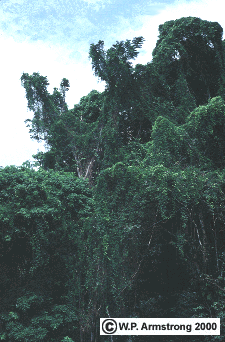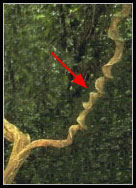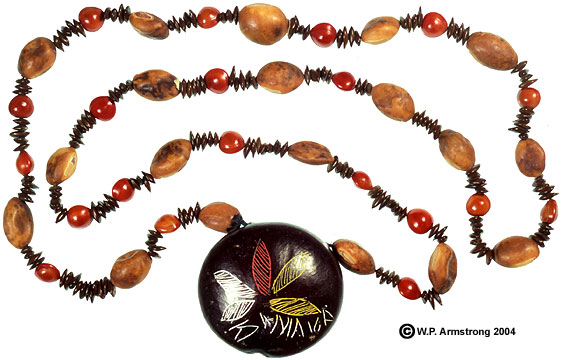|
The World's Longest Legume, Sea Heart Of The Ocean, |
|
The third largest family of flowering plants is the legume or pea family (Fabaceae), with more than 18,000 species. Legumes include a wide range of species, from roadside weeds and valuable crop plants to ornamental shrubs, vines and giant canopy trees of the tropical rain forest. Many legume species contain nitrogen-fixing bacteria inside root nodules which convert inert atmospheric nitrogen into ammonia, thereby making vital nitrogen available to other plants. The seeds of this family are typically produced in pods (called legumes), and come in an astonishing array of shapes and sizes. One question that is repeatedly asked by general botany students is what is the world's largest (longest) legume? The undisputed record for the longest bean pod is the sea heart (Entada gigas).
Not only does Entada gigas produce the longest bean pod of any legume, this tropical vine also produces large, heart-shaped seeds that ride the ocean currents of the world. Twining through the forest canopy like a botanical boa constrictor, sea heart vines are one of the most remarkable lianas of the New World tropics. Known locally as "escalera de mono" or "monkey ladder," sea heart vines actually provide arboreal thoroughfares for monkeys high in the rain forest canopy.
To appreciate the abundance of lianas in Central American rain forests, consider tiny Barro Colorado Island, located in the Panama Canal Zone. According to Francis E. Putz (Ecology Vol. 65, 1984), Barro Colorado has more than 600 lianas per acre, growing on 43 percent of the canopy trees. Liana seedlings grow very fast and often get their start at the forest edge or in "gaps" where trees have fallen and sunlight floods in. With the intense competition for space and light, growing rapidly to the tops of trees is a marvelous adaptation. According to Edwin A. Menninger (Flowering Vines of the World, 1970), the monkey ladder may grow 100 feet in 18 months. Like a writhing snake, a single monkey ladder may climb the tallest tree before it branches and winds through several tree crowns over 100 feet above the forest floor. Some trees become so heavily draped with luxuriant lianas that they are toppled by the wind. Although their support tree may fall, many lianas remain rooted in the ground and simply climb to the tops of neighboring trees.
The monkey ladder is widely distributed throughout wet lowland forests of the New World tropics. Along riverbanks and the margins of forests this massive liana may completely drape tall trees with a green curtain of leafy vines. Dense spikes of small greenish-yellow flowers hang from the axils of tendril-bearing, bipinnate leaves. Although the individual blossoms are not that showy compared to some legumes, the fruits are truly wonders of the plant kingdom. At maturity the elongate, twisted, brown pod may be three to six feet (1 to 2 meters) in length, the longest of any legume. When they hang from the tops of huge vines, it reminds one of Jack's fabulous adventure when he climbed the legendary bean stalk.

Although they are very large, the pods of monkey ladder are rather flimsy and typically break apart into 15 or more one-seeded compartments. In fact, the forest floor is often littered with these sections, several connected to each other by a tough, woody cord. Each section contains a shiny, brown seed resembling a large bean made of polished hardwood. The seeds may be two and one-half inches (6 centimeters) across and often resemble wooden hearts. Because of a hollow cavity adjacent to the seed embryo and a thick, woody covering, the seed is very buoyant and resistant to decay. Torrential rains commonly wash the seeds into streams and rivers where they are carried into the sea. Here the seeds start a new career as "sea hearts" in one of nature's most fascinating stories. Literally millions of sea hearts ride the ocean currents of the world, drifting for months or years--eventually washing ashore on the beaches of distant continents or exotic tropical islands.
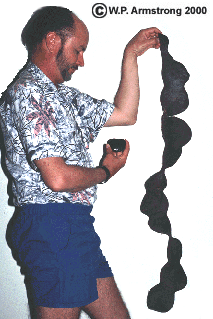

Another species of monkey ladder (Entada phaseoloides) is widely distributed throughout the Old World tropics, including Africa, southeast Asia and Polynesian islands of the South Pacific. The large, woody seeds are similar in size to E. gigas, although they tend to be more rounded or rectangular in shape. Because the seeds were hollowed out and filled with snuff, they are often called "snuff-box sea beans." The pods generally do not exceed three feet in length, and they are more woody and stiff than E. gigas. One reference states that the pods of E. phaseoloides were used at one time for clubs by police in the West Indies. It is hard to imagine that the large, flimsy pods would offer much of a deterrent to criminals. During the past 50 years, many authors have listed both species of monkey ladder as E. scandens, a pantropic liana whose distribution was derived from ocean drifting. According to Charles R. Gunn and J.V. Dennis (World Guide to Tropical Drift Seeds and Fruits, 1976), either E. phaseoloides gave rise to the New World species E. gigas, or they both had a common ancestor.



Throughout the ages, the seeds of both species of monkey ladder have been fashioned into all sorts of trinkets and useful objects. The seeds were cut in half, the contents removed, and the woody seed coats hinged together. Hollowed out seeds were commonly used in Norway and Northern Europe for snuff boxes, match boxes and beautiful lockets. The hard seeds take a high polish and their intrinsic value was enhanced with a fine finish of tung oil or lacquer. Sometimes the polished surface displayed the embossed initials of the proud owner. The attractive seeds of Entada phaseoloides have also been used in children's games and Polynesian leis. 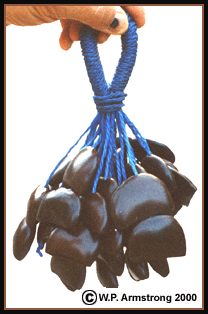

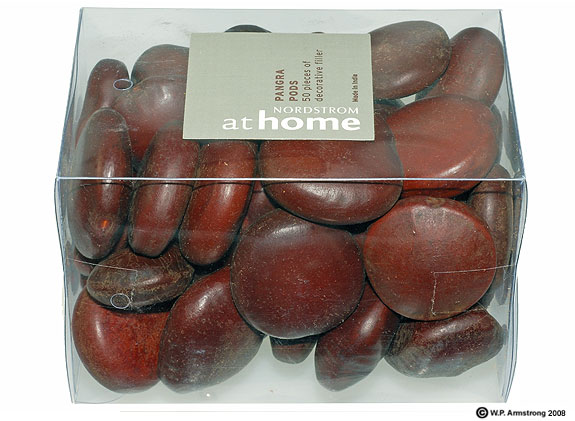
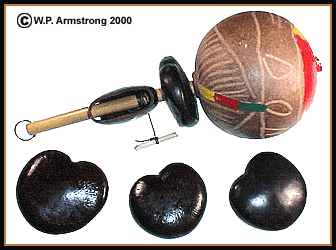
The seeds of monkey ladder were ground into a poultice to relieve painful inflammations. Ground seeds were also taken internally for an incredible variety of remedies, including contraception, constipation, snake bites, and as an aphrodisiac in India. In addition, the powdered seeds were reportedly used as a coffee adulterant and for food. Some species of Entada also have a high saponin content. Pieces of the roots and stems macerated in water produce a soapy lather. In Central America, species of Entada have been used as a natural shampoo and laundry soap. 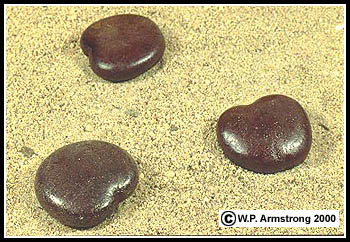
Sea hearts are commonly carried by Caribbean currents to the Gulf of Mexico and beaches of the Florida Keys. The most perfectly shaped hearts are highly prized by beach combers. Sea hearts drifting off the east coast of Florida may ride the Gulf Stream and North Atlantic Currents to Northern Europe. Drift bottle studies conducted by the U.S. Coast and Geodetic Survey indicate that a journey from Yucatan to Ireland may take about one year. Sometimes sea hearts have deep imprints and lacerations, possibly caused by the teeth of ravenous fish during the perilous voyage. Sea hearts are impervious to salt water, and even after floating in ocean water for several years.

Sea hearts have a long and colorful history in fact and fiction. Early naturalists thought the unusual heart-shaped seeds came from strange underwater plants whose origin was shrouded in mystery. Christopher Columbus was fascinated with objects that drifted ashore on beaches of the Azores off the coast of Portugal. It is said that a sea heart provided inspiration to Columbus and led him to set forth in search of lands to the west. In fact, the sea heart is called "fava de Colom" or "Columbus bean" by Portuguese residents of the Azores. In Norway, a bitter tea was made from sea hearts to relieve pain during childbirth. In England, sea hearts were used as teething rings and as good luck charms for sailors embarking on a long ocean voyage. If sea hearts could survive a long and perilous journey across the ocean, perhaps they could also protect their owner. Sea hearts were also carried as an amulet to protect the owner from sickness and to ward off evil spirits. Sea hearts commonly wash ashore on islands of the Caribbean, and in Jamaica they are beautifully hand painted and sold as lucky pendants.
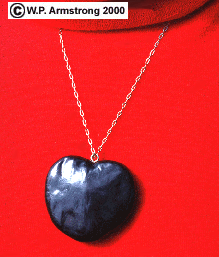
From tree tops of the lush tropical rain forest to the high seas, few plants have journeyed farther than the monkey ladder. And few seeds have aroused the curiosity and imagination of people like the beautiful sea heart. In fact, the inspiration of Christopher Columbus and the many ramifications of his voyage to the New World are mind boggling.
|
|
|



